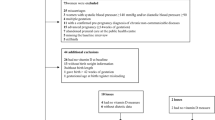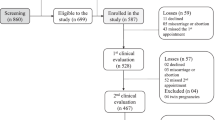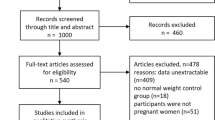Abstract
Objectives
To evaluate the association between vitamin D status during pregnancy and total gestational weight gain (GWG), GWG rates and postpartum weight retention.
Methods
Prospective cohort of 163 women from Rio de Janeiro was followed at 5th–13th (baseline), 20th–26th, 30th–36th gestational weeks and at 30–62 days postpartum. Plasma 25-hydroxyvitamin D [25(OH)D] was evaluated during each trimester and was categorized as adequate (≥50 nmol/L) or inadequate (<50 nmol/L). GWG (kg) was calculated as the difference between the weight measured at baseline and 36th–42th gestational weeks. GWG rates (kg/week) were calculated between each visit. Postpartum weight retention (kg) was analysed as the difference between weights measured at 30–62 days postpartum and 5th–13th gestational weeks. Statistical analyses were performed using linear regression models that included interaction terms between vitamin D status and first trimester body mass index (BMI) (<25/≥25 kg/m2). Confounders were selected based on a directed acyclic graph.
Results
The prevalence of vitamin D inadequacy was 16.6%, 9.9% and 10.6% in the first, second and third trimesters, respectively. Overweight women with vitamin D inadequacy in the first (β = 3.70; 95% CI 0.09; 7.31, p-value = 0.045) and third trimester (β = 4.59, 95% CI 0.07; 9.10, p-value = 0.047) presented higher increases in total GWG than did women with vitamin D adequacy. This association was also observed between first trimester vitamin D status and GWG rates between visits 1 and 2 (β = 0.17; 95% CI 0.13; 0.36, p-value = 0.07).
Conclusions
There was an interaction effect of first trimester BMI (≥25 kg/m2) on the association between first and third trimester vitamin D status and GWG.
This is a preview of subscription content, access via your institution
Access options
Subscribe to this journal
Receive 12 print issues and online access
$259.00 per year
only $21.58 per issue
Buy this article
- Purchase on Springer Link
- Instant access to full article PDF
Prices may be subject to local taxes which are calculated during checkout

Similar content being viewed by others
References
Holick MF. Vitamin D deficiency. N Engl J Med. 2007;357:266–81.
Holick MF, Binkley NC, Bischoff-Ferrari HA, Gordon CM, Hanley DA, Heaney RP, et al. Evaluation, treatment, and prevention of vitamin D deficiency: an endocrine society clinical practice guideline. J Clin Endocrinol Metab. 2011;96:1911–30.
Figueiredo ACC, Cocate PG, Adegboye ARA, Franco-Sena AB, Farias DR, de Castro MBT, et al. Changes in plasma concentrations of 25-hydroxyvitamin D and 1,25-dihydroxyvitamin D during pregnancy: a Brazilian cohort. Eur J Nutr. 2018;57:1059–72.
Saraf R, Morton SM, Camargo CA, Grant CC. Global summary of maternal and newborn vitamin D status—a systematic review. Matern Child Nutr. 2016;12:647–68.
Hossein-nezhad A, Holick MF. Vitamin D for health: a global perspective. Mayo Clin Proc. 2013;88:720–55.
Tous M, Villalobos M, Iglesias L, Fernández-Barrés S, Arija V. Vitamin D status during pregnancy and offspring outcomes: a systematic review and meta-analysis of observational studies. Eur J Clin Nutr. 2019. [Epub ahead of print].
Aghajafari F, Nagulesapillai T, Ronksley PE, Tough SC, O’Beirne M, Rabi DM. Association between maternal serum 25-hydroxyvitamin D level and pregnancy and neonatal outcomes: systematic review and meta-analysis of observational studies. BMJ. 2013;346:f1169.
Zhang Y, Gong Y, Xue H, Xiong J, Cheng G. Vitamin D and gestational diabetes mellitus: a systematic review based on data free of Hawthorne effect. BJOG. 2018;125:784–93.
Wei SQ, Audibert F, Hidiroglou N, Sarafin K, Julien P, Wu Y, et al. Longitudinal vitamin D status in pregnancy and the risk of pre‐eclampsia. BJOG. 2012;119:832–9.
Brandenbarg J, Vrijkotte TG, Goedhart G, van, Eijsden M. Maternal earlypregnancy vitamin D status is associated with maternal depressive symptoms in the Amsterdam born children and their development cohort. Psychosom Med. 2012;74:751–7.
Cunha Figueiredo AC, Trujillo J, Freitas-Vilela AA, Franco-Sena AB, Rebelo F, Cunha GM, et al. Association between plasma concentrations of vitamin D metabolites and depressive symptoms throughout pregnancy in a prospective cohort of Brazilian women. J Psychiatr Res. 2017;95:1–8.
Barchitta M, Maugeri A, Quattrocchi A, Agrifoglio O, Agodi A. The role of miRNAs as biomarkers for pregnancy outcomes: a comprehensive review. Int J Genom. 2017;2017:8067972.
Maugeri A, Barchitta M, Blanco I, Agodi A. Effects of vitamin D supplementation during pregnancy on birth size: a systematic review and meta-analysis of randomized controlled trials. Nutrients. 2019;11:442.
Nobles CJ, Markenson G, Chasan-Taber L. Early pregnancy vitamin D status and risk for adverse maternal and infant outcomes in a bi-ethnic cohort: the Behaviors Affecting Baby and You (B.A.B.Y.) Study. Br J Nutr. 2015;114:2116–28.
Hollis JL, Crozier SR, Inskip HM, Cooper C, Godfrey KM, Harvey NC, et al. Modifiable risk factors of maternal postpartum weight retention: an analysis of their combined impact and potential opportunities for prevention. Int J Obes. 2017;41:1091–8.
Martins MEP, Esmeraldo CUP, Sabiá JPD, Carvalho JHL, Suano-Souza FI, Sarni ROS. Vitamin D postpartum concentrations: relationship with nutritional condition and morbidities during pregnancy. J Pregnancy. 2018;2018:1070528.
Institute of Medicine and National Research Council (US) Committee to Reexamine IOM Pregnancy Weight Guidelines. Rasmussen KM, Yaktine AL, editors. Weight gain during pregnancy: reexamining the guidelines, Washington, DC: The National Academies Press; 2009.
Mehmood ZH, Papandreou D. An updated mini review of vitamin D and obesity: adipogenesis and inflammation state. Open Access Maced J Med Sci. 2016;4:526–32.
Wimalawansa SJ. Associations of vitamin D with insulin resistance, obesity, type 2 diabetes, and metabolic syndrome. J Steroid Biochem Mol Biol. 2018;175:177–89.
Goldstein RF, Abell SK, Ranasinha S, Misso M, Boyle JA, Black MH, et al. Association of gestational weight gain with maternal and infant outcomes: a systematic review and meta-analysis. JAMA. 2017;317:2207–25.
Yao Y, Zhu L, He L, Duan Y, Liang W, Nie Z, et al. A meta-analysis of the relationship between vitamin D deficiency and obesity. Int J Clin Exp Med. 2015;8:14977–84.
Bani-Issa W, Eldeirawi K, Harfil S, Fakhry R. Vitamin D deficiency and its determinants in adults: a sample from community-based settings in the United Arab Emirates. Int J Endocrinol. 2017;2017:3906306.
Sneve M, Figenschau Y, Jorde R. Supplementation with cholecalciferol does not result in weight reduction in overweight and obese subjects. Eur J Endocrinol. 2008;159:675–84.
Mason C, Xiao L, Imayama I, Duggan C, Wang CY, Korde L, et al. Vitamin D3 supplementation during weight loss: a double-blind randomized controlled trial. Am J Clin Nutr. 2014;99:1015–25.
Institute of Medicine. Dietary reference intakes for calcium and vitamin D. Washington, DC: The National Academies Press; 2011.
Santos S, Eekhout I, Voerman E, Gaillard R, Barros H, Charles MA, et al. Gestational weight gain charts for different body mass index groups for women in Europe, North America, and Oceania. BMC Med. 2018;16:201.
Sichieri R, Everhart JE. Validity of a Brazilian food frequency questionnaire against dietary recalls and estimated energy intake. Nutr Res. 1998;18:1649–59.
Tabela Brasileira de Composição de Alimentos (TACO—Brazilian Food Composition Table). Universidade Estadual de Campinas: Campinas; 2011. http://www.unicamp.br/nepa/taco.
USDA. Agricultural Research Service. USDA National Nutrient Database for Standard Reference, release 24. Nutrient Data Laboratory Home Page; 2011. http://www.ars.usda.gov/ba/bhnrc/ndl.
Textor J, Hardt J, Knüppel S. DAGitty: a graphical tool for analyzing causal diagrams. Epidemiology. 2011;22:745.
Pathak K, Soares MJ, Calton EK, Zhao Y, Hallett J. Vitamin D supplementation and body weight status: a systematic review and meta-analysis of randomized controlled trials. Obes Rev. 2014;15:528–37.
Subih HS, Zueter Z, Obeidat BM, Al-Qudah MA, Janakat S, Hammoh F, et al. high weekly dose of cholecalciferol and calcium supplement enhances weight loss and improves health biomarkers in obese women. Nutr Res. 2018;59:53–64.
Ekwaru JP, Zwicker JD, Holick MF, Giovannucci E, Veugelers PJ. The importance of body weight for the dose response relationship of oral vitamin D supplementation and serum 25-hydroxyvitamin D in healthy volunteers. PLoS ONE. 2014;9:e111265.
Golzarand M, Hollis BW, Mirmiran P, Wagner CL, Shab-Bidar S. Vitamin D supplementation and body fat mass: a systematic review and meta-analysis. Eur J Clin Nutr. 2018;72:1345–57.
Mallard SR, Howe AS, Houghton LA. Vitamin D status and weight loss: a systematic review and meta-analysis of randomized and nonrandomized controlled weight-loss trials. Am J Clin Nutr. 2016;104:1151–9.
Manson JE, Brannon PM, Rosen CJ, Taylor CL. Vitamin D deficiency—is there really a pandemic? N Engl J Med. 2016;375:1817–20.
McDonnell SL, Baggerly CA, French CB, Baggerly LL, Garland CF, Gorham ED. Breast cancer risk markedly lower with serum 25-hydroxyvitamin D concentrations ≥60 vs <20 ng/ml (150 vs 50 nmol/L): Pooled analysis of two randomized trials and a prospective cohort. PLoS ONE. 2018;13:e0199265.
Wagner CL, Hollis BW. The implications of vitamin D status during pregnancy on mother and her developing child. Front Endocrinol. 2018;31:500.
Wong KE, Kong J, Zhang W, Szeto FL, Ye H, Deb DK, et al. Targeted expression of human vitamin D receptor in adipocytes decreases energy expenditure and induces obesity in mice. J Biol Chem. 2011;286:33804–10.
Soares MJ, Pathak K, Calton EK. Calcium and vitamin D in the regulation of energy balance: where do we stand? Int J Mol Sci. 2014;15:4938–45.
Abbas MA. Physiological functions of vitamin D in adipose tissue. J Steroid Biochem Mol Biol. 2017;165(Pt B):369–81.
Blumberg JM, Tzameli I, Astapova I, Lam FS, Flier JS, Hollenberg AN. Complex role of the vitamin D receptor and its ligand in adipogenesis in 3T3-L1 cells. J Biol Chem. 2006;281:11205–13.
Mutt SJ, Hyppönen E, Saarnio J, Järvelin MR, Herzig KH. Vitamin D and adipose tissue-more than storage. Front Physiol. 2014;5:228.
Acknowledgements
The authors are grateful to all participants of the cohort study, to the Municipal Health Centre Heitor Beltrão for giving us the space and allow the completion of data collection.
Funding
This study was supported by grants from National Council for Scientific and Technological Development CNPq (grant number: 471196/2010-0) and Carlos Chagas Filho Foundation for Research Support of Rio de Janeiro State (FAPERJ, grant number: E-26/110.681/2012).
Author information
Authors and Affiliations
Contributions
The authors’ contributions are as follows: GK designed the research; DRF conducted the research; ACCF analysed the data; ACCF wrote the paper with input from TPR, MAB, DRF and EGB; GK reviewed the manuscript; ACCF and GK had primary responsibility for final content. All authors read and approved the final manuscript.
Corresponding author
Ethics declarations
Conflict of interest
The authors declare that they have no conflict of interest.
Ethics approval
The Research Ethics Committees of the Municipal Secretariat of Health and Civil Defense of the State of Rio de Janeiro approved this study (Protocol number: 0012.0.249.000-09). Written consent from all participants was freely obtained, after all necessary clarifications were provided in accordance with the principles of the Declaration of Helsinki.
Additional information
Publisher’s note: Springer Nature remains neutral with regard to jurisdictional claims in published maps and institutional affiliations.
Supplementary information
Rights and permissions
About this article
Cite this article
Figueiredo, A.C.C., Carrilho, T.R.B., Batalha, M.A. et al. Association between vitamin D status during pregnancy and total gestational weight gain and postpartum weight retention: a prospective cohort. Eur J Clin Nutr 74, 126–134 (2020). https://doi.org/10.1038/s41430-019-0465-2
Received:
Revised:
Accepted:
Published:
Issue Date:
DOI: https://doi.org/10.1038/s41430-019-0465-2
This article is cited by
-
Maternal plasma vitamin D levels across pregnancy are not associated with neonatal birthweight: findings from an Australian cohort study of low-risk pregnant women
BMC Pregnancy and Childbirth (2023)
-
Gender-related differences in the association of serum levels of vitamin D with body mass index in northern Iranian population: the PERSIAN Guilan Cohort Study (PGCS)
BMC Nutrition (2022)
-
Relationship between vitamin D status in the first trimester of the pregnancy and gestational weight gain: a mediation analysis
Archives of Gynecology and Obstetrics (2022)
-
The effect of prepregnancy body mass index on maternal micronutrient status: a meta-analysis
Scientific Reports (2021)



